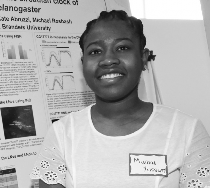Muibat Yussuff
 Rosbash Laboratory
Rosbash Laboratory
Department of Biology
Brandeis University
Investigation of CG17777 in the Circadian Clock of Drosophila Melanogaster
Poster Abstract
Circadian rhythms are physiological and behavioral adaptations in an intrinsic 24-hour cycle. Circadian rhythms are highly conserved across species from bacteria to mammals, which makes the fruit fly a productive model system to investigate the mechanisms behind clock regulation. Approximately 150 neurons in the Drosophila brain function together to regulate circadian rhythms. Neuropeptides in these clock neurons play important roles in controlling both behaviors and physiological processes such as sleep, circadian rhythms, feeding, and mating. Although many neuropeptides are known to help maintain the circadian clock, it is still unclear how all of these clock neurons communicate with each other or outside of the clock circuit. In an effort to characterize additional neuropeptides that act within the circadian neuronal circuit, one of the five candidate neuropeptides from prior RNA sequencing results will be further investigated to determine their potential roles in the circadian clock. CC17777 is a particularly interesting candidate because previous RNA sequencing of the clock neurons showed that it is expressed in three distinct neuronal clock clusters, including the morning and evening pacemaker neurons. Circadian experiments show that CG17777 is necessary in the morning and evening pacemaker neurons to maintain rhythmicity, while sleep experiments show that CG17777 is required in a third clock cluster (DN1s) to inhibit daytime sleep. Together, this indicates that CG17777 plays different roles in the circadian clock. In the future, we will test if knocking-out CG17777 in different clock neurons lead to changes in sleep and locomotor activity.
Personal Statement
I started working at the Rosbash lab in the spring of my sophomore year. I knew instantly that research was for me and it was something that I plan on doing for the rest of my life. This summer, I worked on continuing my research on investigating a candidate neuropeptide called CG17777 and identifying its role in the circadian clock. With the help of the M.R. Bauer Foundation, I was able to stay at the lab and work on a project I am extremely passionate about. I performed various circadian and sleep experiments using CG17777 knock-down flies to understand how their rhythmicity and sleep patterns are different from flies without the CG17777 knock-down. I also learned various new skills like brain dissections, different antibody staining protocols, and microscopy to visualize the clock neurons. I am very grateful to the foundation for giving me the opportunity to expand my knowledge outside the classroom. My experiences this summer have strengthened my passion for research and has driven me to pursue research in the future.